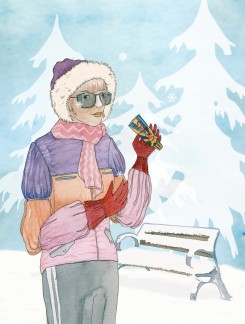According to recent statistics, roughly 20 students at the University of Toronto will be diagnosed with some form of skin cancer this year around early March. The culprits are not only the dangerous UVA and UVB sunrays that are penetrating skin everywhere but also the self-destructive behaviours that many undergraduates choose to engage in. UVA rays cause skin cancers and premature aging and the higher wavelength UVB rays cause burning.
The winter sun can cause an even greater amount of sunburn and skin damage than the summer sun. While sand, for example, reflects only 25 per cent of UV radiation, snow reflects a staggering 80 per cent of the sun’s rays. Moreover, the risk of sun damage is greater at higher altitudes as UV radiation increases by 4 per cent for every 1,000–foot increase in altitude. Sunlight may be least intense during the winter months, and cloudy skies may make the air cooler, but UV rays still pass through the clouds, and over 70 per cent of UVB radiation occurs during the winter.
As young adults, we may take our elastic skin for granted and may not realize that sun damage is cumulative. Studies have shown that the areas you spend the majority of your time in throughout the day can actually become more dangerous than a single visit to an indoor tanning salon. This means that throughout your lifetime, the small amounts of UV light that your skin is exposed day-to-day foster the growth of microscars that can lead not only to skin cancer but also photoaging, where skin loses its ability to repair itself because the growth of new collagen is impeded. Moreover, UV radiation is highest between the hours of 10 am to 4 pm, so keep in mind that you aren’t safe from dangerous rays that pass through the glass windows in libraries and classrooms.
The best line of defense against skin cancer and permanent skin damage is the application of a broad, full-spectrum SPF 30 or more sunscreen that blocks both UVA and UVB rays regularly. Looking for products that contain zinc oxide and titanium dioxide as active ingredients is a good way to ensure better coverage than that offered by chemical-based sunscreens. Physical blockers just aren’t as effective. Dermatologists advise against using anything less than SPF 30 and encourage the application of sunscreen at least 15 minutes before going outside, in addition to reapplication every two hours to ensure potency after sun exposure. Apart from eating fruits and vegetables high in antioxidants that fight free radicals and wearing a petroleum-infused lip balm, investing in a good pair of sunglasses with a UV coating on the lenses is highly recommended to keep your skin safe this winter season. If you’re a regular skier, you should wear a large-brimmed hat when going outside as a knit stocking cap isn’t enough to protect your face.
One final note: refrain from using tanning beds under all circumstances. Not only do they damage the skin with artificial UVA radiation that leads to skin cancer, but they also reduce the capacity of the immune system. If you’re truly insecure about your skin tone, consider using tanning sprays, lotions, and bronzing powder. Keep your skin safe as it gets colder this winter season!


